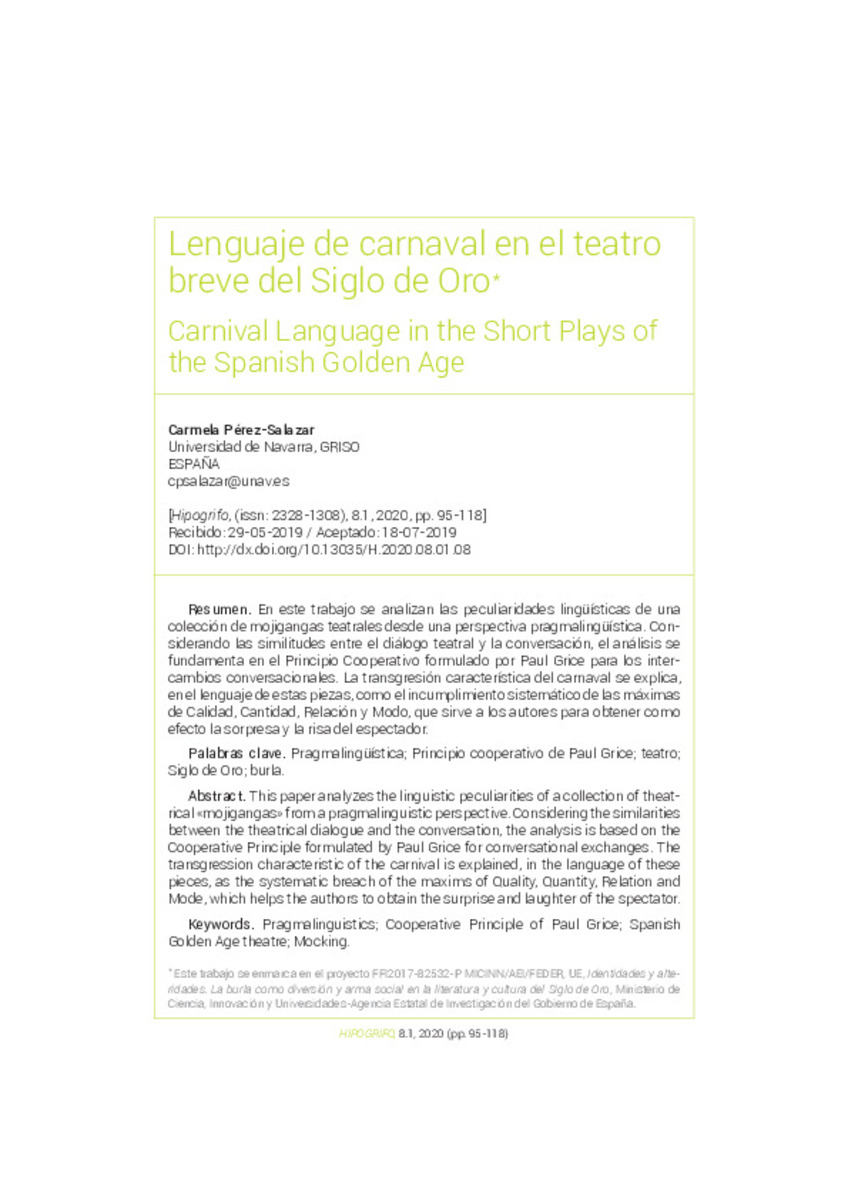Full metadata record
| DC Field | Value | Language |
|---|---|---|
| dc.creator | Pérez-Salazar-Resano, C. (Carmela) | - |
| dc.date.accessioned | 2023-02-23T14:18:41Z | - |
| dc.date.available | 2023-02-23T14:18:41Z | - |
| dc.date.issued | 2020 | - |
| dc.identifier.citation | Pérez-Salazar-Resano, C. (Carmela). "Lenguaje de carnaval en el teatro breve del Siglo de Oro". Hipogrifo. 8 (1), 2020, 95 - 118 | es_ES |
| dc.identifier.issn | 2328-1308 | - |
| dc.identifier.uri | https://hdl.handle.net/10171/65540 | - |
| dc.description.abstract | En este trabajo se analizan las peculiaridades lingüísticas de una colección de mojigangas teatrales desde una perspectiva pragmalingüística. Considerando las similitudes entre el diálogo teatral y la conversación, el análisis se fundamenta en el Principio Cooperativo formulado por Paul Grice para los intercambios conversacionales. La transgresión característica del carnaval se explica, en el lenguaje de estas piezas, como el incumplimiento sistemático de las máximas de Calidad, Cantidad, Relación y Modo, que sirve a los autores para obtener como efecto la sorpresa y la risa del espectador. | es_ES |
| dc.description.abstract | This paper analyzes the linguistic peculiarities of a collection of theatrical «mojigangas» from a pragmalinguistic perspective. Considering the similarities between the theatrical dialogue and the conversation, the analysis is based on the Cooperative Principle formulated by Paul Grice for conversational exchanges. The transgression characteristic of the carnival is explained, in the language of these pieces, as the systematic breach of the maxims of Quality, Quantity, Relation and Mode, which helps the authors to obtain the surprise and laughter of the spectator. | es_ES |
| dc.description.sponsorship | Este trabajo se enmarca en el proyecto FFI2017-82532-P MICINN/AEI/FEDER, UE, Identidades y alteridades. La burla como diversión y arma social en la literatura y cultura del Siglo de Oro, Ministerio de Ciencia, Innovación y Universidades-Agencia Estatal de Investigación del Gobierno de España. | es_ES |
| dc.language.iso | spa | es_ES |
| dc.relation | info:eu-repo/grantAgreement/AEI/Plan Estatal de Investigación Científica y Técnica y de Innovación 2013-2016/FFI2017-82532-P/ES/IDENTIDADES Y ALTERIDADES. LA BURLA COMO DIVERSION Y ARMA SOCIAL EN LA LITERATURA Y CULTURA DEL SIGLO DE ORO | es_ES |
| dc.rights | info:eu-repo/semantics/openAccess | es_ES |
| dc.subject | Pragmalingüística | es_ES |
| dc.subject | Principio cooperativo de Paul Grice | es_ES |
| dc.subject | Teatro Siglo de Oro | es_ES |
| dc.subject | Burla | es_ES |
| dc.subject | Pragmalinguistics | es_ES |
| dc.subject | Cooperative Principle of Paul Grice | es_ES |
| dc.subject | Spanish Golden Age theatre | es_ES |
| dc.subject | Mocking | es_ES |
| dc.title | Lenguaje de carnaval en el teatro breve del Siglo de Oro | es_ES |
| dc.title.alternative | Carnival Language in the Short Plays of the Spanish Golden Age | es_ES |
| dc.type | info:eu-repo/semantics/article | es_ES |
| dc.publisher.place | Navarra | es_ES |
| dc.description.note | Revista bajo una Licencia Creative Commons Atribución-NoComercial-SinDerivadas 3.0 Unported. | es_ES |
| dc.identifier.doi | 10.13035/H.2020.08.01.08 | - |
| dadun.citation.endingPage | 118 | es_ES |
| dadun.citation.number | 1 | es_ES |
| dadun.citation.publicationName | Hipogrifo | es_ES |
| dadun.citation.startingPage | 95 | es_ES |
| dadun.citation.volume | 8 | es_ES |
Files in This Item:
Statistics and impact
Items in Dadun are protected by copyright, with all rights reserved, unless otherwise indicated.






